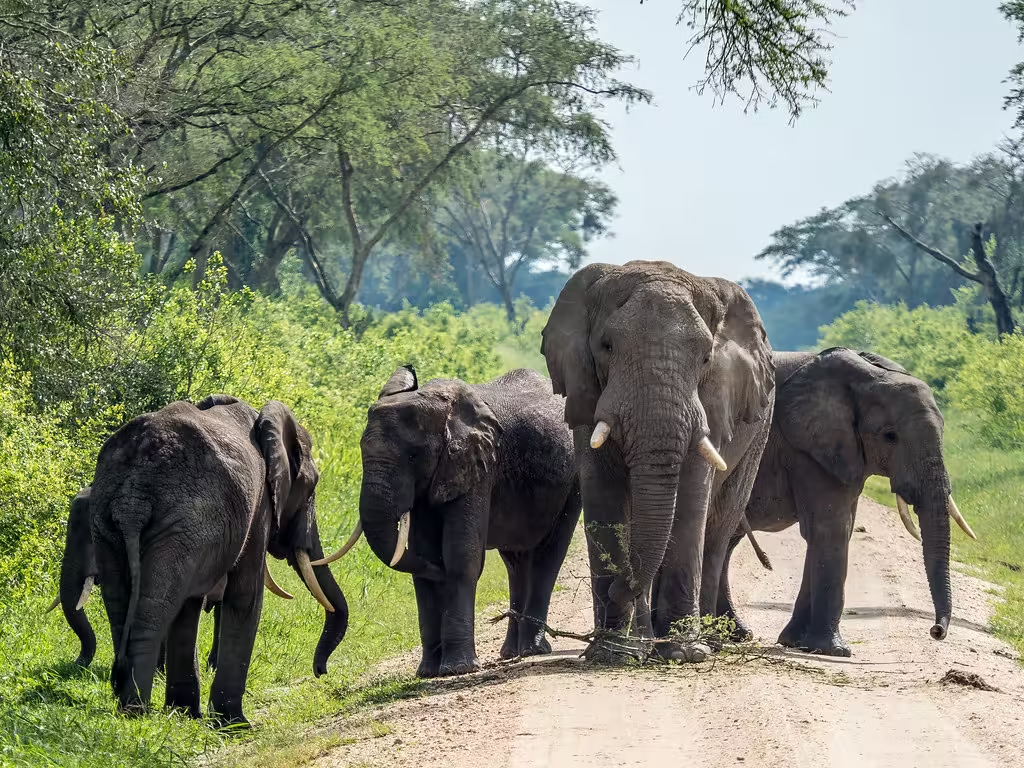Elephants in Uganda: Majestic Giants of the Wild-Where to see elephants in Uganda-Elephant safaris in Uganda-Wildlife in Queen Elizabeth National Park-Elephant conservation Uganda.

Elephants are one of Uganda’s most iconic wildlife species, symbolizing the grandeur and diversity of its natural heritage. Uganda is home to African elephants, the largest land mammals on Earth. These magnificent creatures can be found in several national parks and reserves across the country, offering visitors unforgettable encounters.
Types of Elephants in Uganda
Uganda hosts two types of African elephants:
Savannah Elephants
These are found in open grasslands and savannahs; these are the larger and more commonly sighted species in Uganda.
Forest Elephants
Smaller and more elusive, forest elephants are found in the dense forests of parks like Bwindi Impenetrable Forest and Kibale National Park.
Where to See Elephants in Uganda
Uganda’s national parks and reserves provide excellent opportunities for spotting elephants in their natural habitats. Here are the top destinations:
1. Queen Elizabeth National Park
Home to a significant population of Savannah elephants, Queen Elizabeth National Park offers one of the best chances to see these giants up close.
The Kasenyi Plains and Mweya Peninsula are hotspots for elephant sightings, particularly during game drives and boat safaris along the Kazinga Channel.
2. Murchison Falls National Park
The largest national park in Uganda boasts a thriving population of elephants, often seen grazing near the Nile River.
The sight of elephants drinking or bathing along the riverbanks with the dramatic Murchison Falls as a backdrop is unforgettable.
3. Kidepo Valley National Park
Remote wilderness known for its rugged landscapes and low tourist density, Kidepo offers exclusive elephant sightings.
Elephants are frequently seen roaming the Narus and Kidepo Valleys.
4. Kibale National Park
Though primarily known for chimpanzees, Kibale hosts smaller forest elephants. These are harder to spot but occasionally encountered during forest treks.
5. Bwindi Impenetrable Forest National Park
Bwindi is better known for gorillas, but lucky visitors might come across forest elephants in the dense undergrowth.
6. Ziwa Rhino and Wildlife Ranch
While primarily a rhino sanctuary, Ziwa also has a growing population of elephants, offering a more controlled setting for viewing.
Elephant Behavior in Uganda
Social Structure
Elephants live in matriarchal herds, with adult females leading groups of younger elephants. Adult males often roam alone.
Diet
Elephants are herbivores, consuming up to 300 pounds of vegetation daily. They play a vital ecological role by dispersing seeds and shaping their habitats.
Communication
Elephants communicate through low-frequency rumbles, body language, and even vibrations that travel through the ground.
Best Time to See Elephants in Uganda
The dry seasons (June to September and December to February) are the best times to spot elephants. During these periods:
Vegetation is sparse, making wildlife easier to see.
Elephants often congregate near water sources, increasing your chances of encounters.
Challenges Facing Elephants in Uganda
Despite their protected status, elephants in Uganda face several threats:
Poaching: Although significantly reduced, poaching for ivory remains a challenge.
Human-Wildlife Conflict: Expanding agriculture and human settlements lead to conflicts when elephants raid crops or damage property.
Habitat Loss: Deforestation and land conversion for farming reduce the elephants’ natural habitats.
Conservation Efforts for Elephants in Uganda

Uganda has made significant strides in elephant conservation through the following initiatives:
Protected Areas: National parks and reserves provide safe havens for elephants.
Anti-Poaching Patrols: Uganda Wildlife Authority (UWA) employs rangers and surveillance technology to combat poaching.
Community Engagement: Programs that involve local communities in conservation efforts reduce human-wildlife conflict and promote coexistence.
Ecotourism: Revenue generated from tourism supports conservation and anti-poaching initiatives, directly benefiting elephant populations.
Activities Involving Elephants in Uganda
Game Drive: Explore parks like Queen Elizabeth and Murchison Falls to see elephants roaming freely.
Boat Safaris: The Kazinga Channel and the Nile River offer incredible opportunities to observe elephants near water.
Photography: Capture stunning images of elephants against Uganda’s breathtaking landscapes.
Nature Walks: In places like Ziwa Rhino Sanctuary, you can observe elephants on guided walks.
Why Elephants are Special in Uganda
Uganda’s elephants contribute significantly to its ecosystems by maintaining the balance of vegetation and providing opportunities for seed dispersal.
Moreover, their presence enriches Uganda’s tourism industry, drawing visitors from around the globe. Encountering these intelligent and majestic creatures in Uganda is an awe-inspiring experience that fosters appreciation for wildlife and conservation.
Fun Facts About Elephants
Elephants are highly intelligent, with excellent memory and problem-solving skills.
They can swim long distances and are known to enjoy playing in water.
An elephant’s trunk has over 40,000 muscles, allowing them to perform delicate tasks like picking up a single blade of grass.

